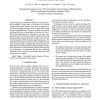Free Online Productivity Tools
i2Speak
i2Symbol
i2OCR
iTex2Img
iWeb2Print
iWeb2Shot
i2Type
iPdf2Split
iPdf2Merge
i2Bopomofo
i2Arabic
i2Style
i2Image
i2PDF
iLatex2Rtf
Sci2ools
ISBI
2007
IEEE
2007
IEEE
Wavelet-Based Statistical Analysis for Optical Imaging in Mouse Olfactory Bulb
Optical imaging is a powerful technique to map brain function in animals. In this study, we consider in vivo optical imaging of the murine olfactory bulb, using an intrinsic signal and a genetically expressed activity reporter fluorescent protein (synaptopHfluorin). The aim is to detect odor-evoked activations that occur in small spherical structures of the olfactory bulb called glomeruli. We propose a new way of analyzing this kind of data that combines a linear model (LM) fitting along the temporal dimension, together with a discrete wavelet transform (DWT) along the spatial dimensions. We show that relevant regressors for the LM are available for both types of optical signals. In addition, the spatial wavelet transform allows us to exploit spatial correlation at different scales, and in particular to extract activation patterns at the expected size of glomeruli. Our framework also provides a statistical significance for every pixel in the activation maps and it has strong type ...
| Added | 03 Jun 2010 |
| Updated | 03 Jun 2010 |
| Type | Conference |
| Year | 2007 |
| Where | ISBI |
| Authors | Dimitri Van De Ville, Brice Bathellier, Alan Carleton, Thierry Blu, Michael Unser |
Comments (0)

